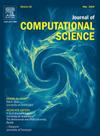Solution of stress and deformation field and inversion of material parameter for gravity dams based on physics-informed neural networks
IF 3.7
3区 计算机科学
Q2 COMPUTER SCIENCE, INTERDISCIPLINARY APPLICATIONS
引用次数: 0
Abstract
The stress and deformation analysis of concrete gravity dams is a core component of evaluating the structural safety of dam bodies. To obtain accurate and efficient solutions for the stress![]() deformation fields of gravity dams and fast inversion of material parameter, based on physics-informed neural networks (PINNs), we develop a residual minimization-based PINN model and a potential energy minimization-based EPINN model specifically targeted at gravity dams, which are grounded in the elasticity theory of solid mechanics. Through various case studies involving gravity dams, the computational accuracy and efficiency of different PINN models are compared. The results show the following: (1) The EPINN model demonstrates superior solving capability and computational efficiency—it is approximately 20 times faster than the PINN model—when dealing with complex geometries and boundary conditions. Conversely, the PINN model achieves higher computational accuracy for simpler geometries, with its precision being approximately twice that of the EPINN model. (2) Both models exhibit strong capabilities in material parameter inversion. In particular, the PINN model achieves accurate inversion of material properties via extremely limited data samples, with errors of only 0.46 % for the elastic modulus E and 2.32 % for Poisson's ratio μ. (3) The convergence performance of PINNs is influenced by factors such as the number of hidden layers, the number of neurons, and the test displacement functions. Overall, PINNs serve as a machine learning method that enables the direct construction of mechanistic models for gravity dams, contributing to the rapid and intelligent assessment of dam structural safety.
deformation fields of gravity dams and fast inversion of material parameter, based on physics-informed neural networks (PINNs), we develop a residual minimization-based PINN model and a potential energy minimization-based EPINN model specifically targeted at gravity dams, which are grounded in the elasticity theory of solid mechanics. Through various case studies involving gravity dams, the computational accuracy and efficiency of different PINN models are compared. The results show the following: (1) The EPINN model demonstrates superior solving capability and computational efficiency—it is approximately 20 times faster than the PINN model—when dealing with complex geometries and boundary conditions. Conversely, the PINN model achieves higher computational accuracy for simpler geometries, with its precision being approximately twice that of the EPINN model. (2) Both models exhibit strong capabilities in material parameter inversion. In particular, the PINN model achieves accurate inversion of material properties via extremely limited data samples, with errors of only 0.46 % for the elastic modulus E and 2.32 % for Poisson's ratio μ. (3) The convergence performance of PINNs is influenced by factors such as the number of hidden layers, the number of neurons, and the test displacement functions. Overall, PINNs serve as a machine learning method that enables the direct construction of mechanistic models for gravity dams, contributing to the rapid and intelligent assessment of dam structural safety.
基于物理信息神经网络的重力坝应力变形场求解及材料参数反演
混凝土重力坝的应力变形分析是评价坝体结构安全性的核心内容。为了准确有效地求解重力坝的应力变形场和快速反演材料参数,基于物理信息神经网络(PINN),以固体力学弹性理论为基础,建立了针对重力坝的残差最小化PINN模型和势能最小化EPINN模型。通过各种重力坝实例研究,比较了不同PINN模型的计算精度和效率。结果表明:(1)在处理复杂几何形状和边界条件时,EPINN模型的求解能力和计算效率比PINN模型快约20倍。相反,对于更简单的几何形状,PINN模型的计算精度更高,其精度大约是EPINN模型的两倍。(2)两种模型均具有较强的材料参数反演能力。特别是,PINN模型通过极其有限的数据样本实现了材料性能的精确反演,弹性模量E的误差仅为0.46 %,泊松比μ的误差仅为2.32 %。(3) pinn的收敛性能受到隐藏层数、神经元数和测试位移函数等因素的影响。总体而言,pinn作为一种机器学习方法,可以直接构建重力坝的力学模型,有助于快速智能地评估大坝结构安全。
本文章由计算机程序翻译,如有差异,请以英文原文为准。
求助全文
约1分钟内获得全文
求助全文
来源期刊

Journal of Computational Science
COMPUTER SCIENCE, INTERDISCIPLINARY APPLICATIONS-COMPUTER SCIENCE, THEORY & METHODS
CiteScore
5.50
自引率
3.00%
发文量
227
审稿时长
41 days
期刊介绍:
Computational Science is a rapidly growing multi- and interdisciplinary field that uses advanced computing and data analysis to understand and solve complex problems. It has reached a level of predictive capability that now firmly complements the traditional pillars of experimentation and theory.
The recent advances in experimental techniques such as detectors, on-line sensor networks and high-resolution imaging techniques, have opened up new windows into physical and biological processes at many levels of detail. The resulting data explosion allows for detailed data driven modeling and simulation.
This new discipline in science combines computational thinking, modern computational methods, devices and collateral technologies to address problems far beyond the scope of traditional numerical methods.
Computational science typically unifies three distinct elements:
• Modeling, Algorithms and Simulations (e.g. numerical and non-numerical, discrete and continuous);
• Software developed to solve science (e.g., biological, physical, and social), engineering, medicine, and humanities problems;
• Computer and information science that develops and optimizes the advanced system hardware, software, networking, and data management components (e.g. problem solving environments).
 求助内容:
求助内容: 应助结果提醒方式:
应助结果提醒方式:


